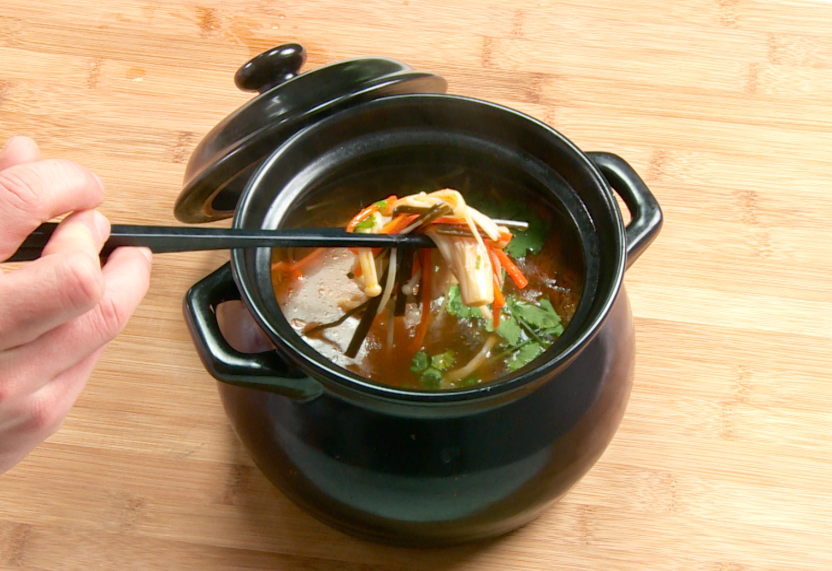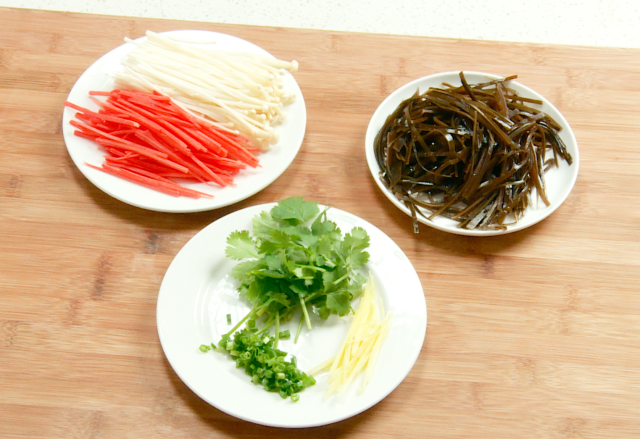Enoki Mushroom Recipe
Enoki Mushroom and Kelp Soup is a healthy and delicious homemade soup that combines the tenderness of enoki mushrooms with the refreshing taste of kelp. Using chicken or vegetable broth as the base enhances the depth of the soup. Sautéing ginger strips and green onions adds aroma, while adding carrots and chili powder enriches the flavor. The soup is light, tasty, and nutritious, making it a perfect choice for your dining table.


 32 Comments
32 Comments
When making enoki mushroom and kelp soup, you should pay attention to the following points and consider some tips to enhance the flavor of the soup and improve the cooking process:
1.Purchasing Ingredients:
Enoki Mushrooms: Can be found in Asian supermarkets or the Asian food section of large chain supermarkets.
Kelp: You can choose dried kelp or ready-to-eat kelp. Dried kelp needs to be soaked in advance and is usually available in Asian supermarkets or health food stores.
Spices and Seasonings: Basic seasonings like salt, chili powder, and ginger can be found in regular supermarkets.
2.Ingredient Preparation:
Soaking Kelp: If using dried kelp, soak it for at least 30 minutes to 1 hour until it softens.
Preparing Enoki Mushrooms: Remove the roots and rinse them clean with water.
3.Flavor Enhancement Tips:
Broth Base: Use chicken broth or vegetable broth instead of water as the soup base to add depth and complexity to the soup.
Sautéing Aromatics: Before boiling the soup, sauté ginger strips and green onions in the pot to release more aroma and make the soup more flavorful.
4.Cooking Steps:
Blanching Step: Blanching not only removes the fishy smell of kelp but also makes it more refreshing in texture.
Heat Control: Keep the soup simmering on medium-low heat to prevent over-boiling, which can cause the ingredients to overcook and lose texture.
5.Seasoning and Garnishing:
Adding Seasonings: Add salt, chili powder, and other seasonings to taste.
Adding Cilantro: Add cilantro just before serving to maintain its fresh texture and fragrance.
6.Health Considerations:
Reduce Fats: Choose healthy cooking oils like olive oil and use them sparingly when sautéing.
Low-Sodium Options: Control the amount of salt, and consider using low-sodium soy sauce or other low-sodium seasonings as substitutes.
7.Other Suggestions:
Ingredient Substitutions: If enoki mushrooms are unavailable, use other crisp mushrooms like sliced mushrooms or shiitake mushrooms.
Varied Ingredients: Add other vegetables like spinach or tofu to increase the nutritional value and texture of the soup.
8.Sand Pot Usage Tips:
Preheating and Cooling: Avoid extreme temperature changes with the sand pot. Pre-soak with warm water before use, avoid placing the pot directly from the refrigerator onto the heat, and do not rinse a hot pot with cold water.
Heat Control: Use medium-low heat, especially at the start of cooking, to prevent the pot from cracking.
Using a Heat Diffuser: Place a heat diffuser or trivet under the pot to avoid direct contact with the stove flame or heating element.
Cleaning and Storage: Clean the pot with warm water and a soft cloth, avoiding steel wool or abrasive brushes. Ensure it is completely dry before storing.
Avoiding Impacts: The pot is relatively fragile and can crack from impacts. Handle it with care to avoid collisions and drops.
9.Alternative Tools:
If you don't have a sand pot, you can use the following alternatives:
Cast Iron Pot: Cast iron pots have excellent heat retention and even heat distribution, making them ideal for long simmering and soup making.
Ceramic Pot: Heat-resistant ceramic pots are also a good choice with good heat retention.
Stainless Steel Pot: Stainless steel pots heat up quickly but can be used for making soups. It’s recommended to use a thick-bottomed stainless steel pot to prevent burning.
Slow Cooker (Crock-Pot): Slow cookers are electric cookers that can cook for long periods at low temperatures, perfect for soups and stews.
Pressure Cooker: Pressure cookers can shorten cooking time but require careful attention to instructions and safety precautions.
These tips and suggestions can help you make delicious enoki mushroom and kelp soup, ensuring the process is simple and suitable for the availability of local ingredients.
INGREDIENTS
MAIN INGREDIENTS
- 50 grams (about 1.8 oz) soaked kelp, cut into thin strips
- 50 grams (about 1.8 oz) enoki mushrooms, roots removed
- 50 grams (about 1.8 oz) carrot, julienned
ACCESSORIES
- 1 small piece of ginger, julienned
- 1 cilantro, cut into sections
- 1 green onion, sliced into small pieces
SEASONINGS
- 2 teaspoons salt
- 2 teaspoons chili powder
- Some cooking oil
- Some water
DIRECTIONS
STEP 1
Prepare the Ingredients:
Cut the soaked kelp into thin strips.
Remove the roots from the enoki mushrooms and blanch them in boiling water, then drain.
Julienne the carrot and ginger.
Cut the cilantro into sections.
Slice the green onion into small pieces.
Set all prepared ingredients aside.

STEP 2
Blanch the Kelp:
Fill a pot with water and bring it to a boil.
Add the kelp strips to the boiling water, stir to separate them.
Blanch the kelp for 2 minutes, then remove and drain.

STEP 3
Stir-Fry:
Heat some oil in a pan over medium heat.
Add the ginger and green onion, and stir-fry for a few seconds until fragrant.
Add the julienned carrot and stir-fry for a short while.
Add the blanched kelp strips and stir-fry everything together until well mixed.

STEP 4
Simmer in a Clay Pot:
Transfer the stir-fried mixture to a clay pot.
Add enough water to fill most of the pot.
Add 2 teaspoons of salt and 2 teaspoons of chili powder.
Bring the pot to a boil.
Once boiling, add the blanched enoki mushrooms.
Let it simmer for about 3 minutes.
Tip:
If using a clay pot (sand pot), avoid extreme temperature changes to prevent cracking. Preheat the pot with warm water and heat gradually.

STEP 5
Finish and Serve:
Add the cilantro sections to the pot.
Serve hot and enjoy your delicious kelp and enoki mushroom hot pot!

Recipe analyzer
- Recipes: Enoki Mushroom Recipe
- Main Ingredients:6
- Servings per recipe:1
- Servings size:165 g
-
Energy (calories):187 kcal
-
Protein:6.01 g
-
Fat:0.87 g
Why gray?

-
Carbohydrates:46.58 g
-
Protein: 8%16 kcal
-
Fat: 4%7 kcal
-
Carbohydrates: 88%164 kcal

The ratio shows whether the proportion of both fatty acids in your diet is optimal. Red color means too much of Omega 6 or too little of Omega 3. The data are rounded off and approximate.







32 REVIEWS